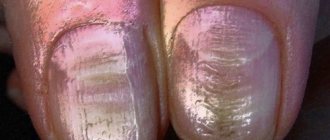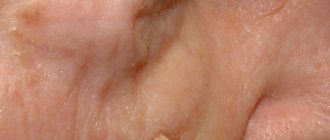Why do such metamorphoses occur in our body, how to live with it, what to replace animal milk with? Our expert answers your questions
Marina Aryaeva
clinical immunologist, allergist, candidate of medical sciences, member of the Association of Honored Doctors of Russia
– Most often, the ability to digest milk (lactose) disappears at the age of 5–7 years, because we stop producing a special enzyme for breaking down lactose.
This is a normal physiological mechanism. However, there are cases when newborns suffer from lactose intolerance: the so-called hypolactasia of newborns. The cause of this problem is insufficient activity of digestive enzymes due to the immaturity of the digestive organs. That is, when a child is born and begins to eat, organs that previously did not work begin to function, but not to their full potential. As a result, insufficiently active digestive enzymes are produced that are unable to break down lactose.
And this is already a serious problem, because the physiological food for babies is mother’s milk. The solution in this situation is special mixtures with hydrolyzed (already broken down) proteins. In addition, such children are given a medicine containing lactase, an enzyme that breaks down lactose.
Neonatal hypolactasia is relatively rare in Russia, accounting for one case per 50,000 newborns
Don't confuse allergies and intolerances
A milk allergy occurs when the immune system begins to produce specific antibodies against milk proteins entering the body. The immune system mistakes them for enemies and fights them. This occurs due to insufficiently active enzymes and the body's inability to digest (absorb) milk sugar (lactose). As a result, large, underdigested milk proteins (especially casein) are perceived by our immune system as parasites or worms. And then it begins to produce antihelminthic antibodies. It is these antibodies that cause allergies.
In children, allergies manifest themselves in the form of redness on the cheeks and on the folds of the arms. Severe itching occurs. The same reactions can occur on the mucous membrane of the gastrointestinal tract, that is, an immunological reaction begins there that damages the mucous membrane.
Why is it important to know if you have an intolerance?
When dairy products enter our body, they give us:
- macroelements: calcium, magnesium, potassium, sodium, phosphorus, chlorine, sulfur, phosphates, citrates and chlorides
- trace elements: iron, copper, zinc, manganese, cobalt, iodine, molybdenum, fluorine, aluminum, silicon, selenium, tin, chromium, lead, etc.
- vitamins: almost the entire line of B vitamins, vitamins E, D, H, C, beta-carotene
- proteins, fats and carbohydrates
We are now clear that dairy products are important. They are essential for maintaining bone mineral density. Regular intake of dairy products helps reduce the risk of bone fractures and osteoporosis.
Recent studies claim that consuming dairy products reduces the risks of type 2 diabetes and obesity.
Now let's imagine that after taking milk, you feel unwell, and you decide to completely eliminate it, which means that everything useful that is in milk. But discomfort after eating has happened to everyone, and not necessarily due to lactose intolerance. Therefore, you should not decide without tests that you need to eliminate dairy.
Take a blood test for lactose intolerance with a geneticist's conclusion with a 30% discount
A geneticist will examine the results, tell you whether you have genetic prerequisites for lactose intolerance, and advise you on how to adjust your diet (if necessary).
If you can't have milk, but really want it
Try to consume milk and dairy products less often. As an alternative to cow's milk, you can use dairy products with already hydrolyzed proteins or consume plant milk (soy, rice, coconut, etc.). This milk contains neither caseins nor lactose. Plant milk contains other sugars – fructose and glucose.
There is an opinion among consumers that people who are allergic to milk or have milk protein intolerance should consume milk that has been boiled for 10–15 minutes. During this time, the allergen - β-lactoglobulin (milk protein) will disintegrate in it. But it's better not to do that. Boiling denatures the protein and inactivates all enzymes. It is better for such people to consume very rarely fermented dairy products, or milk of plant origin, or hydrolyzed mixtures. Fermented milk products such as kefir, yogurt and cottage cheese are already fermented by bacteria during the souring process and are digested much better by most people. In addition, souring also changes other properties of milk: lactose turns into lactic acid, casein is partially broken down.
Roskoshestvo examined milk from famous brands. Details HERE
What happens if you drink milk if you are lactose intolerant?
You drank milk, it entered the intestines. Your gastrointestinal tract begins to digest it to take the best from the milk. Enzymes are used for this. One of them is lactase (lactase, not to be confused with lactose).
If there is little lactase in the small intestine or it is not very active, then a lot of unbroken lactose accumulates in the intestine. To remove it, the body sends water to the intestines. This leads to loose stools (diarrhea).
As soon as lactose and water reach your colon, they are immediately joined by bacteria that are in the intestines. Together they form fatty acids and gas. This causes pain, rumbling, bloating and gas. This condition is called lactose intolerance (lactase deficiency, LN). At the same time, everything useful that you ate and drank does not have time to be absorbed and comes out along with diarrhea.
Let's remember about the water that the body sent to remove lactose. Water should have remained in the body, but you lost it. This can cause dehydration.
Each person reacts differently to lactose. Some people can drink liters of milk, others can eat porridge with milk. And someone gets sick from a sandwich with doctor's sausage. Depending on how your body responds to lactose, you may have: √
good lactose tolerance ○ moderate (variable) lactose tolerance ✘ lactose intolerance
Tests for diagnosing hypolactasia
No specific tests are needed to make a diagnosis - usually the doctor can diagnose hypolactasia based on the patient’s complaints, or the patient can do it independently, based on the symptoms and reaction of the body after drinking milk.
Occasionally, a hydrogen test is used in medical practice. It lasts about four hours: first, doctors measure the amount of hydrogen in the air that the patient exhales, then ask him to take some lactose, and then measure the hydrogen content again at hourly intervals. Bacteria that break down undigested lactase release hydrogen, so if its content has changed, a diagnosis of hypolactasia is made.
Allergy or not?
Denying the allergic nature of milk intolerance, allergists are right in their own way. The cause is a pathology of the enzyme system of the digestive organs, so it is more correct to call this condition lactose deficiency. The latter can be either congenital - due to a mutation of the corresponding gene, or acquired, when the activity of producing the lactose enzyme, which breaks down milk sugar, decreases with age.
A secondary form of pathology can be caused by intestinal diseases, as well as giardiasis, enteritis, immune lesions of the intestines, pancreatitis - both acute and chronic. Observation of the dynamics of development shows that with age the activity of these enzymes only decreases. It is not surprising that after 30 years, many people completely refuse to drink milk, although they drank it with pleasure in childhood.
Lactose allergy: diet
If you or your family and friends have such a reaction, you should be very careful about the selection and consumption of food. Among the products there are three main groups:
- containing lactose;
- with its possible content;
- lactose free.
The following should be completely excluded from the diet:
- any milk of animal origin (including breast milk);
- all cheeses, yoghurts;
- cottage cheese, sour cream, mayonnaise;
- butter, all types of milk chocolate and ice cream;
- sports nutrition.
The following group of products may contain lactose in certain quantities:
- bread products, flour, pastries;
- muesli, sweets, chips;
- sausage, wieners, frankfurters;
- all fast food products;
- medicines and alcoholic drinks.
Before purchasing such products, carefully look at the packaging. Typically, manufacturers always indicate whether it contains lactose or not.
You need to take care to include in your diet:
- soy or almond based milk;
- vegetables and fruits;
- cereals;
- fish or seafood;
- dried fruits;
- jams and preserves;
- eggs and whole meat.
Lactase deficiency - causes
The causes of lactase deficiency in adults may be the following:
- inflammatory bowel diseases of bacterial, viral (rotovirus), parasitic (giardiasis) etiology; for example, a rotovirus penetrates the mature cells of the microvilli of the small intestinal mucosa, destroys and rejects them, the mucosal cells cease to form the enzyme lactase, the dysentery bacillus, entering the intestine, produces toxins, causes inflammation throughout the small intestine, multiplies intensively in the ileum and then passes to the large intestine; Giardia lives in the upper small intestine, attaches to the mucosal villi, multiplies, affects the intestinal wall deeper, and disrupts parietal (membrane digestion) by disrupting enzyme production.
- chronic diseases of the stomach, biliary tract, pancreas,
- operations on the gastrointestinal tract,
- endocrine diseases (diabetes mellitus, hyperparathyroidism),
- Whipple's disease is a rare disease of the small intestine;
- gluten enteropathy (celiac disease), with celiac disease the synthesis of all enzymes is disrupted, including lactase, and lactase deficiency occurs, the manifestations of which are significantly reduced by following a gluten-free diet;
- Crohn's disease is a granulomatous enteritis that affects the entire wall of the small intestine in any part of it. Inflammation develops, then scar tissue, and enzyme synthesis stops; damage to the mucous membrane is based on autoimmune mechanisms;
- food allergy - damage to enterocytes (cells of the mucous membrane of the small intestine), it is called allergoenteropathy, which is based on immunoallergic antigen-antibody complexes, the antigen is the food product, and the body produces antibodies; the antigen-antibody complex in cells causes inflammation, the release of neurotransmitters, which leads to damage to enterocytes, and their ability to secrete lactase is impaired;
- bacterial overgrowth in the small intestine;
- lymphoma of the small intestine.
Lactose allergy: what to do?
In addition to following a low-lactose diet, young children are prescribed special mixtures with a reduced content of this substance. The diet for adults and children is prepared individually by a doctor. The doctor prescribes enzymes that will help better absorb other foods and normalize intestinal activity.
If we are talking about congenital intolerance to “milk sugar,” you will have to constantly follow a low-lactose diet. Special milk substitute formulas can be bought in pharmacies or obtained free of charge based on a prescription written by a doctor. The younger the child, the faster it is recommended to introduce him to a low-lactose diet.
For young people and adults, other types of milk are well suited - those based on rice, soy, coconut or oats. These foods contain the required amount of calcium. It is an important element for the strengthening and growth of the human skeletal system.
Food can be prepared using any dairy substitute, and its taste will not become worse. Specialty stores always have soy, rice or oat cream and other products that can successfully replace foods and drinks containing lactose.
With a regular diet and periodic check-ups with your doctor, anyone can learn to live with this disease and lead a healthy lifestyle by developing a number of healthy habits and eating a number of other foods.
Bibliography
- Bahna SL. Cow's milk allergy versus cow milk intolerance // Ann Allergy Asthma Immunol 2002; 89:56.
- Bock SA, Muñoz-Furlong A, Sampson HA. Further fatalities caused by anaphylactic reactions to food, 2001-2006 // J Allergy Clin Immunol 2007; 119:1016.
- Boyce JA, Assa'ad A, et al. Guidelines for the diagnosis and management of food allergy in the United States: report of the NIAID-sponsored expert panel // J Allergy Clin Immunol 2010; 126:S1.
- Chen WL, Hwang MT, Liau CY, et al. Beta-lactoglobulin is a thermal marker in processed milk as studied by electrophoresis and circular dichroic spectra // J Dairy Sci 2005; 88:1618.
- Colver AF, Nevantaus H, Macdougall CF, Cant AJ. Severe food-allergic reactions in children across the UK and Ireland, 1998-2000 // Acta Paediatr 2005; 94:689.
- Docena GH, Fernandez R, Chirdo FG, Fossati CA. Identification of casein as the major allergenic and antigenic protein of cow's milk // Allergy 1996; 51:412.
- Ehn BM, Ekstrand B, Bengtsson U, Ahlstedt S. Modification of IgE binding during heat processing of the cow's milk allergen beta-lactoglobulin // J Agric Food Chem 2004; 52:1398.
- Eigenmann PA, Sicherer SH, Borkowski TA, et al. Prevalence of IgE-mediated food allergy among children with atopic dermatitis // Pediatrics 1998; 101:E8.
- Ellman LK, Chatchatee P, Sicherer SH, Sampson HA. Food hypersensitivity in two groups of children and young adults with atopic dermatitis evaluated a decade apart // Pediatr Allergy Immunol 2002; 13:295.
- Fiocchi A, Brozek J, Schünemann H, et al. World Allergy Organization (WAO) Diagnosis and Rationale for Action against Cow's Milk Allergy (DRACMA) Guidelines // Pediatr Allergy Immunol 2010; 21 Suppl 21:1.
- Fiocchi A, Schünemann HJ, Brozek J, et al. Diagnosis and Rationale for Action Against Cow's Milk Allergy (DRACMA): a summary report // J Allergy Clin Immunol 2010; 126:1119.
- García-Ara C, Boyano-Martínez T, Díaz-Pena JM, et al. Specific IgE levels in the diagnosis of immediate hypersensitivity to cows' milk protein in the infant // J Allergy Clin Immunol 2001; 107:185.
- Gaudin JC, Rabesona H, Choiset Y, et al. Assessment of the immunoglobulin E-mediated immune response to milk-specific proteins in allergic patients using microarrays // Clin Exp Allergy 2008; 38:686.
- Heine RG, Elsayed S, Hosking CS, Hill DJ. Cow's milk allergy in infant // Curr Opin Allergy Clin Immunol 2002; 2:217.
- Hill DJ, Heine RG, Hosking CS. The diagnostic value of skin prick testing in children with food allergy // Pediatr Allergy Immunol 2004; 15:435.
- Høst A, Halken S. A prospective study of cow milk allergy in Danish infants during the first 3 years of life. Clinical course in relation to clinical and immunological type of hypersensitivity reaction // Allergy 1990; 45:587.
- Høst A. Cow's milk protein allergy and intolerance in infants. Some clinical, epidemiological and immunological aspects // Pediatr Allergy Immunol 1994; 5:1.
- Iyngkaran N, Robinson MJ, Sumithran E, et al. Cows' milk protein-sensitive enteropathy. An important factor in prolonging diarrhoea of acute infectious enteritis in early infancy // Arch Dis Child 1978; 53:150.
- Jansen JJ, Kardinaal AF, Huijbers G, et al. Prevalence of food allergy and intolerance in the adult Dutch population // J Allergy Clin Immunol 1994; 93:446.
- Järvinen KM, Chatchatee P. Mammalian milk allergy: clinical suspicion, cross-reactivities and diagnosis // Curr Opin Allergy Clin Immunol 2009; 9:251.
- Järvinen KM, Sicherer SH, Sampson HA, Nowak-Wegrzyn A. Use of multiple doses of epinephrine in food-induced anaphylaxis in children // J Allergy Clin Immunol 2008; 122:133.
- Kuitunen P, Visakorpi JK, Savilahti E, Pelkonen P. Malabsorption syndrome with cow's milk intolerance. Clinical findings and course in 54 cases // Arch Dis Child 1975; 50:351.
- Lam HY, van Hoffen E, Michelsen A, et al. Cow's milk allergy in adults is rare but severe: both casein and whey proteins are involved // Clin Exp Allergy 2008; 38:995.
- Levy Y, Segal N, Garty B, Danon YL. Lessons from the clinical course of IgE-mediated cow milk allergy in Israel // Pediatr Allergy Immunol 2007; 18:589.
- Luyt D, Ball H, Makwana N, et al. BSACI guideline for the diagnosis and management of cow's milk allergy // Clin Exp Allergy 2014; 44:642.
- Moissidis I, Chaidaroon D, Vichyanond P, Bahna SL. Milk-induced pulmonary disease in infants (Heiner syndrome) // Pediatr Allergy Immunol 2005; 16:545.
- Natale M, Bisson C, Monti G, et al. Cow's milk allergens identification by two-dimensional immunoblotting and mass spectrometry // Mol Nutr Food Res 2004; 48:363.
- Ngamphaiboon J, Chatchatee P, Thongkaew T. Cow's milk allergy in Thai children // Asian Pac J Allergy Immunol 2008; 26:199.
- Niggemann B, Sielaff B, Beyer K, et al. Outcome of double-blind, placebo-controlled food challenge tests in 107 children with atopic dermatitis // Clin Exp Allergy 1999; 29:91.
- Nowak-Wegrzyn A, Bloom KA, Sicherer SH, et al. Tolerance to extensively heated milk in children with cow's milk allergy // J Allergy Clin Immunol 2008; 122:342.
- Osterballe M, Hansen TK, Mortz CG, et al. The prevalence of food hypersensitivity in an unselected population of children and adults // Pediatr Allergy Immunol 2005; 16:567.
- Osterballe M, Mortz CG, Hansen TK, et al. The prevalence of food hypersensitivity in young adults // Pediatr Allergy Immunol 2009; 20:686.
- Perry TT, Matsui EC, Kay Conover-Walker M, Wood RA. The relationship of allergen-specific IgE levels and oral food challenge outcome // J Allergy Clin Immunol 2004; 114:144.
- Pumphrey RS, Gowland MH. Further fatal allergic reactions to food in the United Kingdom, 1999-2006 // J Allergy Clin Immunol 2007; 119:1018.
- Rona RJ, Keil T, Summers C, et al. The prevalence of food allergy: a meta-analysis // J Allergy Clin Immunol 2007; 120:638.
- Saarinen KM, Juntunen-Backman K, Järvenpää AL, et al. Supplementary feeding in maternity hospitals and the risk of cow's milk allergy: A prospective study of 6209 infants // J Allergy Clin Immunol 1999; 104:457.
- Sampson HA, Mendelson L, Rosen JP. Fatal and near-fatal anaphylactic reactions to food in children and adolescents // N Engl J Med 1992; 327:380.
- Sampson HA. Utility of food-specific IgE concentrations in predicting symptomatic food allergy // J Allergy Clin Immunol 2001; 107:891.
- Schrander JJ, van den Bogart JP, Forget PP, et al. Cow's milk protein intolerance in infants under 1 year of age: a prospective epidemiological study // Eur J Pediatr 1993; 152:640.
- Shek LP, Soderstrom L, Ahlstedt S, et al. Determination of food specific IgE levels over time can predict the development of tolerance in cow's milk and hen's egg allergy // J Allergy Clin Immunol 2004; 114:387.
- Sicherer SH, Sampson HA. Food hypersensitivity and atopic dermatitis: pathophysiology, epidemiology, diagnosis, and management // J Allergy Clin Immunol 1999; 104:S114.
- Sicherer SH, Teuber S, Adverse Reactions to Foods Committee. Current approach to the diagnosis and management of adverse reactions to foods // J Allergy Clin Immunol 2004; 114:1146.
- Skripak JM, Matsui EC, Mudd K, Wood RA. The natural history of IgE-mediated cow's milk allergy // J Allergy Clin Immunol 2007; 120:1172.
- Stöger P, Wüthrich B. Type I allergy to cow milk proteins in adults. A retrospective study of 34 adult milk- and cheese-allergic patients // Int Arch Allergy Immunol 1993; 102:399.
- Uguz A, Lack G, Pumphrey R, et al. Allergic reactions in the community: a questionnaire survey of members of the anaphylaxis campaign // Clin Exp Allergy 2005; 35:746.
- Vandenplas Y, Koletzko S, Isolauri E, et al. Guidelines for the diagnosis and management of cow's milk protein allergy in infants // Arch Dis Child 2007; 92:902.
- Wal JM. Bovine milk allergenicity // Ann Allergy Asthma Immunol 2004; 93:S2.
- Wang J, Godbold JH, Sampson HA. Correlation of serum allergy (IgE) tests performed by different assay systems // J Allergy Clin Immunol 2008; 121:1219.
- Woods RK, Abramson M, Bailey M, Walters EH. International prevalences of reported food allergies and intolerances. Comparisons arising from the European Community Respiratory Health Survey (ECRHS) 1991-1994 // Eur J Clin Nutr 2001; 55:298.
Symptoms
Typically, symptoms manifest themselves half an hour to an hour after drinking more than 250 ml of milk. It includes:
- diarrhea;
- colic;
- bloating;
- gurgling sounds in the stomach;
- flatulence;
- urge to defecate.
In children, intolerance can cause weight loss if dairy products are a significant part of the child's diet.
Typically, a person suffering from hypolactasia consciously or subconsciously realizes that he cannot “digest” milk and practically refuses it from his daily diet.











